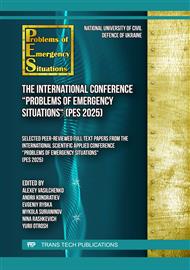[1]
A. Athamena, A. Gaagai, H.A. Aouissi, J. Burlakovs, S. Bencedira, I. Zekker, & A.E. Krauklis, Chemometrics of the environment: hydrochemical characterization of groundwater in Lioua plain (North Africa) using time series and multivariate statistical analysis. Sustainability. 15(1) (2022) 20.
DOI: 10.3390/su15010020
Google Scholar
[2]
J. Liu, C. Yang, S. Chen, Y. Wang, X. Zhang, W. Kang, ... & X. Yuan, Hydrochemical Appraisal and Driving Forces of Groundwater Quality and Potential Health Risks of Nitrate in Typical Agricultural Area of Southwestern China. Water. 15(23) (2023) 4095.
DOI: 10.3390/w15234095
Google Scholar
[3]
V. Loboichenko, N. Nikitina, N. Leonova, O. Konovalova, A. Bondarenko, O. Zemlianskyi, & N. Rashkevich, Study of the features of determination of heavy metals in bottom sediments. In IOP Conference Series: Earth and Environmental Science. 1348 (2024) 1 012014. IOP Publishing.
DOI: 10.1088/1755-1315/1348/1/012014
Google Scholar
[4]
V. Loboichenko, N. Leonova, N. Nikitina, Ye. Savchenko, N. Rashkevich, O. Shevchenko, & A. Khmyrova, Ensuring environmental safety during express determination of individual components of plant raw materials in aqueous solutions. IOP Conf. Ser.: Earth Environ. Sci. 1491 (2025) 012027
DOI: 10.1088/1755-1315/1491/1/012027
Google Scholar
[5]
Z. Cheng, Y. Zheng, R. Mortlock, & A. Van Geen, Rapid multi-element analysis of groundwater by high-resolution inductively coupled plasma mass spectrometry. Analytical and bioanalytical chemistry. 379 (2004) 512–518.
DOI: 10.1007/s00216-004-2618-x
Google Scholar
[6]
T. Giblin, & W.T. Frankenberger, Rapid detection of perchlorate in groundwater using capillary electrophoresis. Chromatographia. 52 (2000) 505–508.
DOI: 10.1007/bf02535727
Google Scholar
[7]
G. MacDonald, J. Levison, & B. Parker, On methods for in‐well nitrate monitoring using optical sensors. Groundwater Monitoring & Remediation. 37(4) (2017) 60–70.
DOI: 10.1111/gwmr.12248
Google Scholar
[8]
O. Koshliakov, & S. Kosharna, Feasible Ways of Improving the Groundwater Monitoring System'Organization in Ukraine. In 17th International Conference Monitoring of Geological Processes and Ecological Condition of the Environment. 2023 (2023) 1 1–5). European Association of Geoscientists & Engineers.
DOI: 10.3997/2214-4609.2023520078
Google Scholar
[9]
A. Myroshnychenko, V. Loboichenko, M. Divizinyuk, A. Levterov, N. Rashkevich, O. Shevchenko, & R. Shevchenko, Application of Up-to-Date Technologies for Monitoring the State of Surface Water in Populated Areas Affected by Hostilities. Bulletin of the georgian national academy of sciences. 16 3 (2022) 50–59.
Google Scholar
[10]
J.K. Thakur, Optimizing groundwater monitoring networks using integrated statistical and geostatistical approaches. Hydrology. 2(3) (2015) 148–175.
DOI: 10.3390/hydrology2030148
Google Scholar
[11]
R.K. Rai, P. Shyamsundar, M. Nepal, & L.D. Bhatta, Financing watershed services in the foothills of the Himalayas. Water. 10(7) (2018) 965.
DOI: 10.3390/w10070965
Google Scholar
[12]
G.S. Herrera, & G.F. Pinder, Space‐time optimization of groundwater quality sampling networks. Water Resources Research. 41(12) (2005).
DOI: 10.1029/2004wr003626
Google Scholar
[13]
S. Zhang, H. Liu, J. Qiang, H. Gao, D. Galar, & J. Lin, Optimization of Well Position and Sampling Frequency for Groundwater Monitoring and Inverse Identification of Contamination Source Conditions Using Bayes' Theorem. Computer Modeling in Engineering & Sciences. 119(2) (2019) 373–394.
DOI: 10.32604/cmes.2019.03825
Google Scholar
[14]
T.R.N. Amanah, T.T. Putranto, & M. Helmi, Application of cluster analysis and principal component analysis for assessment of groundwater quality – A study in Semarang, Central Java, Indonesia. In IOP conference series: earth and environmental science. 248 1 (2019) 012063. IOP Publishing.
DOI: 10.1088/1755-1315/248/1/012063
Google Scholar
[15]
A.E. Marín Celestino, D.A. Martínez Cruz, E.M. Otazo Sánchez, F. Gavi Reyes, & D. Vásquez Soto, Groundwater quality assessment: An improved approach to K-means clustering, principal component analysis and spatial analysis: A case study. Water. 10(4) (2018) 437.
DOI: 10.3390/w10040437
Google Scholar
[16]
M. El-Rawy, H. Fathi, F. Abdalla, F. Alshehri, & H. Eldeeb, An integrated principal component and hierarchical cluster analysis approach for groundwater quality assessment in Jazan, Saudi Arabia. Water. 15(8) (2023) 1466.
DOI: 10.3390/w15081466
Google Scholar


